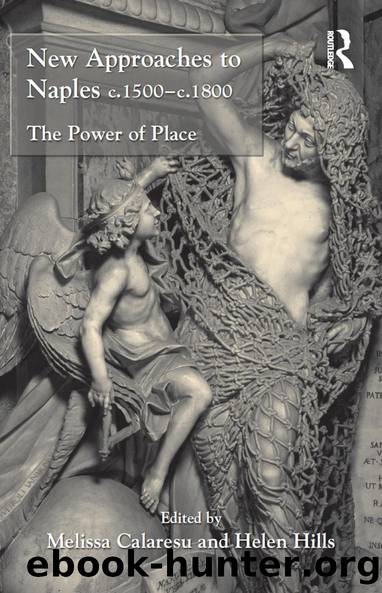New Approaches to Naples c.1500-c.1800 by Helen Hills Melissa Calaresu

Author:Helen Hills, Melissa Calaresu [Helen Hills, Melissa Calaresu]
Language: eng
Format: epub
Tags: History, Modern, 16th Century, Literary Collections, European, General, Social Science, Anthropology, Cultural & Social
ISBN: 9781409429432
Google: Wk9eLwEACAAJ
Publisher: Ashgate
Published: 2013-01-15T16:14:44+00:00
Figure 6.2 Gabriele Ricciardelli, A View of the Bay of Naples, with Vesuvius beyond, seen from the North, 63 à 168 cm, oil on canvas, 1747, Calke Abbey, Derbyshire. © National Trust Images/John Hammond
Figure 6.3 Gabriele Ricciardelli, A View of the Bay of Naples from San Martino with a Fleet at anchor, Vesuvius beyond and the Palazzo di Capodimonte to the left, 63 à 168 cm, oil on canvas, 1747, Calke Abbey, Derbyshire. © National Trust Images/Christopher Hurst
The Hunting Park
In its material conditions and recent history the site represented in the painting of the royal hunt was far removed from the bucolic landscape of the Roman campagna. Identified as Lake Patria, or alternatively as the lake at Fusaro, Vernetâs subject was one of the many hunting reserves that functioned as dominant landscape features of the recently appropriated royal territories arranged as the estates of the siti reali. The new royal estates played a very real role in the re-organization of the kingdomâs territory, even if historians of the siti reali have tended not to consider their development in general, and that of the constituent hunting parks especially, in light of the enclosure movement which, as has been demonstrated, was well under way in the kingdom.33 Almost all the royal building projects, from the acquisition of the first sito reale at Procida to the foundation of the palace complex designed by Luigi Vanvitelli at Caserta, were involved in a royal policy of annexation and appropriation of land from feudal landowners with known Austrian Habsburg sympathies or associations.34 Other siti reali were the outcome of new legislation through which rural territory left intestate automatically reverted to royal patrimony. In 1751 the Giunta delle ricompre (Council of Requisitions) was founded to channel land acquired from both sources to the new royal estates.35
This legislation was strategically important. As a kind of devoluzione (transfer) which meant that in many territories the âfeudal lord was now the king himselfâ, the legislation offered âa sort of ânatural wayâ to the abolition of feudalismâ.36 In 1754 this desire to maximize the crownâs territorial holdings and erode those belonging to the feudal barons motivated the king to insist that as âbaronial possessions were more often than not the result of usurpationâ, the âoriginal deed of transfer [should] be produced in any legal dispute over land between barons and local communitiesâ.37 Writing to his brother about the construction of the Royal Palace at Caserta in 1751 Vanvitelli declared:
When I design Caserta, I shall see to it to make piazzas, churches, monasteries and so on, but right now I cannot do so. The King, before leaving Caserta, ordered Cavalier Neroni to have estimates made of some lands that are included in the area of the garden and the piazza, and to offer the corresponding proprietors other lands or payment in cash, but not to do violence to anyone.38
Even if, as Vanvitelliâs letter suggests, not all the crownâs territorial needs were met through the harsh process of transfer outlined above, the acquisition
Download
This site does not store any files on its server. We only index and link to content provided by other sites. Please contact the content providers to delete copyright contents if any and email us, we'll remove relevant links or contents immediately.
De Catalaanse brief by Robert Goddard(319)
A Piece of Cake by Sarah Swatridge(255)
Churchill's Spearhead by John Greenacre(228)
Nonlinear Dynamics and Chaos with Student Solutions Manual by Steven H. Strogatz(222)
The Ruin of J. Robert Oppenheimer by Priscilla J. McMillan(194)
Popular Culture and Political Identity in the Arab Gulf States by Alanoud Alsharekh Robert Springborg(174)
Flowering of the Cumberland by Harriette Simpson Arnow(174)
thing bounces back europe by Unknown(166)
Allied Bombing Raids by Philip Kaplan(164)
A Japanese View of Nature by Kinji Imanishi Pamela J. Asquith(158)
Guild and State by Antony Black(154)
Comet Madness by Richard J. Goodrich(153)
RAF at the Crossroads by Greg Baughen(143)
History Without A Subject by David Ashley(137)
A History of Greek and Roman Philosophy by John Hackney(136)
The Seventies Now: Culture As Surveillance by Stephen Paul Miller(136)
A History of Science in Society by Ede Andrew;Cormack Lesley B.;(131)
Shocking Bodies by Iwan Rhys Morus(129)
Air Battle for Burma by Evans Bryn;(128)
